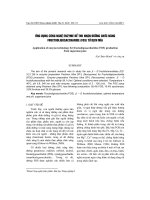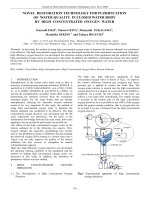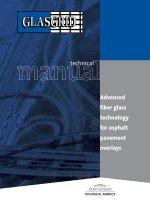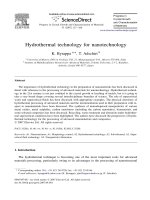coating technology for wood plastic composites
Bạn đang xem bản rút gọn của tài liệu. Xem và tải ngay bản đầy đủ của tài liệu tại đây (9.17 MB, 130 trang )
DEVELOPMENT OF A COATING TECHNOLOGY FOR
WOOD PLASTIC COMPOSITES
By
BARUN SHANKAR GUPTA
A thesis submitted in partial fulfillment of
the requirements for the degree of
MASTER OF SCIENCE IN MATERIALS SCIENCE AND ENGINEERING
WASHINGTON STATE UNIVERSITY
School of Mechanical and Materials Engineering
December 2006
To the Faculty of Washington State University:
The members of the Committee appointed to examine the thesis of
BARUN SHANKAR GUPTA find it satisfactory and recommend that it be
accepted.
___________________________________
Chair
___________________________________
___________________________________
___________________________________
ii
ACKNOWLEDGMENT
I would like to thank my advisor Dr. Marie-Pierre G. Laborie for giving me the
opportunity to work on this wonderful project. I will never forget her exceptional help
and assistance during my project work that kept me dedicated and rewarded to the
project. Secondly, I would like to thank my committee members Dr. Michael Wolcott,
Dr. Kerry Hipps and Dr. Armando McDonald for assisting me during hours of my need.
I would like to thank the Office of Naval Research whose funding provided
financial support for my research. I would also like to thank Drew Paints, Inc. and
Specialty Polymers for providing us the coating materials and other technical details.
I would like to extend my thanks to the staffs of Wood Materials and Engineering
Laboratory. Our director Dr. Don Bender has always spared time for helping me analyze
data and provided the necessary enthusiasm for me to push forward. In addition, my
special thanks go to Judy Edmister, Patricia Smith, Janet Duncan, Bob Duncan, and Scott
Lewis whose cooperative nature endured throughout my work in WMEL. Dr. Karl
Englund has been especially helpful providing resources throughout my work on this
project. Dr. Patrick Pedrow from the EECS helped me to carry out the plasma treatments
in his lab. Dr. Charles Knaack and Dr. Louis Scudiero helped me to perform the X-ray
analyses. Lastly, I want to acknowledge the help by my friends, office mates, and other
colleagues.
iii
DEVELOPMENT OF A COATING TECHNOLOGY FOR
WOOD PLASTIC COMPOSITES
Abstract
by Barun Shankar Gupta, M.S.
Washington State University
December 2006
Chair: Marie-Pierre G. Laborie
Wood plastic composites (WPCs) are gaining increasing popularity in exterior
applications. However, the weatherability of WPCs drives the need for developing
surface finishes that would offer both protection and aestheticism. Developing a suitable
coating system for WPCs requires a thorough understanding of the surface properties,
surface chemistry and wettability in particular, since these properties directly relate to
paint adhesion to WPCs. The first objective of this thesis is therefore to understand the
surface properties of WPCs and their relationship to the adhesion of a standard coating.
The adhesion of coatings to plastics is greatly improved by surface treatments. The
second objective of this research is then to evaluate the impact of common plastic surface
treatments on the surface properties of WPCs and on the adhesion of a standard coating
to WPCs. In performing these objectives, 8 WPC formulations are manufactured
according to a 2
3
full-factorial, so that the effect of formulations on the surface chemistry,
wettability and primer adhesion can be determined. Surface chemistry and wettability are
evaluated using attenuated-total-reflection FTIR (ATR-FTIR) spectroscopic
iv
measurements and dynamic contact angle analysis with water. Primer adhesion to WPC
is determined from an 180
o
Peel test.
Untreated WPCs showed high contact angle (95-105
o
) with water and low surface
energy (31.5 mJ/m
2
) similar to neat polyolefins. As a result, the primer adhesion to
untreated WPCs (177-309 N/m) is intermediate to that of neat polyolefins (126-48 N/m)
and neat wood (526 N/m). The primer adhesion is linearly related to WPC surface
roughness and heterogeneity as determined from contact angle hysteresis.
Moreover, the four surface treatments implemented, oxygen plasma, flame,
ultraviolet (UV)-Benzophenone (BP) and chromic acid increase the primer adhesion to
WPCs by 1.5-2.5 fold. The chromic acid treated (637
+ 88 N/m) and oxygen plasma
treated (516
+ 116 N/m) WPCs show the highest primer adhesion, greater than that with
neat wood. Surface analyses further suggest that different adhesion mechanisms are
responsible for the enhancement in coating adhesion. In the case of plasma treated
WPCs, surface oxidation and therefore primary bonding and secondary interactions likely
play an important role. On the other hand, chromic acid treatment increases surface
roughness significantly resulting in greater interfacial contact for adhesion mechanisms,
Finally, to validate the results obtained on bulk WPCs, the extruded ‘skin’ surface
and the bulk ‘core’ material of WPCs is compared. Concentration of lubricants and
plastic in the ‘skin’ compared to the core yield lower peel load (135
+ 24 N/m)
.
.
v
TABLE OF CONTENTS
Page
ACKNOWLEDGMENT III
ABSTRACT IV
CHAPTERS VI
LIST OF FIGURES IX
LIST OF TABLES XIII
vi
Chapters
Page
CHAPTER ONE 1
1.1 Introduction, Problem Statement, Rationale and Objective 1
1.2 Literature Review 3
1.2.1 Coating of Wood 3
1.2.2 Coating of Plastics 3
1.2.2.1 Flame treatment 5
1.2.2.2 Cold Plasma treatment 6
1.2.2.3 UV treatment 7
1.2.2.4 Chromic Acid treatment 8
1.2.2.5 Other treatments 9
1.2.3 Coating of Wood Plastic Composites (WPCs) 10
References: 15
CHAPTER TWO 18
SURFACE CHARACTERIZATION AND COATINGS OF WOOD PLASTIC
COMPOSITES (WPCs) 18
2.1 Abstract: 18
2.2 Introduction 20
2.3 Experimental 22
2.4 Results and Discussion: 27
2.5 Conclusion 38
References: 40
vii
CHAPTER THREE 42
SCREENING OF DIFFERENT SURFACE ACTIVATION METHODS TO
IMPROVE PAINT ADHESION TO WOOD PLASTIC COMPOSITES (WPC) 42
3.1 Abstract: 42
3.2 Introduction 44
3.3 Experimental 46
3.3.1 Surface Treatments 49
3.3.2 Characterization Methods 50
3.3.3 Adhesion test 55
3.4 Results and Discussion: 56
3.5 Conclusion 85
References: 87
CHAPTER FOUR 91
INFLUENCE OF SKIN-CORE MORPHOLOGY ON PAINT ADHESION TO
WOOD PLASTIC COMPOSITES (WPCs) 91
4.1 Abstract: 91
4.2 Introduction: 92
4.3 Experimental: 94
4.4 Results and Discussion: 98
4.5 Conclusion 106
References: 107
Recommendations 109
viii
Appendix-A 111
ix
List of Figures
Page
Figure 2.1: Absorbance spectra (ATR-FTIR) for WPC, OP-100, polyethylene, wood and
MAPP 25
Figure 2.3: Zisman plot of WPCs (Maple/HDPE/MAPP and Pine/PP/MAPP) 31
Figure 2.3: DCA analysis of WPCs. 32
Figure 2.4: Plot of peel load against OH/CH ratio 35
Figure 2.5: Plot showing the dependence of peel load on advancing contact angle 37
Figure 2.6: Plot showing the dependence of peel load on wetting hysteresis 37
Figure 3.1: ATR-FTIR spectra of PP/Maple/MAPP formulation 53
Figure 3.2: Polar plot of O=C/C-H for different formulations of untreated and treated
WPCs
58
Figure 3.3: Polar plot of O-H/C-H for different formulations of untreated and treated
WPCs 61
Figure 3.4: Relationship between the O=C/C-H and O-H/C-H showing the amount of
surface polarity for the untreated and all treated WPCs. Inset: Relationship between
the O=C/C-H and O-H/C-H showing the amount of surface polarity for the
untreated, flame treated, UV/BP treated and chromic treated WPCs (R
2
=0.77) 62
Figure 3.5: Relationship between C-H/C=O and C-H/O-H showing surface polymer
content on the untreated and treated WPC surface.
63
Figure 3.6: XRD trace of neat wood, HDPE, and neat and treated HDPE/Pine/MAPP
WPC.
65
x
Figure 3.7: Plot showing the wetting behavior of the untreated and treated WPCs during
dynamic contact angle analysis
66
Figure 3.8: Polar plot showing the θ
a
for different formulations of untreated and treated
WPCs 67
Figure 3.9: Relationship between the surface oxidation (O=C/C-H), surface wood content
(O-H/C-H) and advancing contact angle (θ
a
) for the untreated and treated WPCs 69
Figure 3.10: Polar plot showing the wetting hysteresis (mJ/m
2
) for the untreated and
treated formulations of WPCs
70
Figure 3.11: Profilometric scanning of the surface topography for the untreated and
treated HDPE/Pine/MAPP formulations
71
Figure 3.12: SEM micrograph of maple (Acer spp) wood 73
Figure 3.13: SEM micrograph of untreated WPCs 74
Figure 3.14: SEM micrograph of chromic acid treated WPCs 75
Figure 3.15: SEM micrograph of flame treated WPCs 76
Figure 3.16: SEM micrograph of UV/BP treated WPCs 77
Figure 3.18: Polar plot showing the distribution of peel load for different formulations of
untreated and treated WPCs
80
Figure 3.19: Relationship between peel load (N/m) and surface O-H/C-H for untreated
and treated surface of WPCs (R
2
=0.54). Inset: Relationship between peel load and
surface OH/CH for the chromic treated, UV/BP treated, flame treated and untreated
WPCs (R
2
=0.95) 82
Figure 3.20: Plot between the peel load (N/m) and the surface O=C/C-H for the untreated
and treated WPCs.
83
xi
Figure 3.21: Plot between the peel load (N/m) and θ
a
(
o
) for the untreated and treated
WPCs
84
Figure 3.22: Plot between the peel load (N/m) and the wetting hysteresis (mJ/m
2
) for the
untreated and treated WPCs 84
Figure 4.1: XPS low resolution survey spectra for WPCs 99
Figure 4.2: XPS high resolution O1s spectra for WPCs 100
Figure 4.3: XPS high resolution C1s spectra for WPCs 100
Figure 4.4: XRD traces of neat HDPE, wood, extruded surface and bulk material of
WPCs
104
Figure 5.1: Flow chart for the proposed line-up for WPC surface coating 110
Figure A1: Subtraction ATR-FTIR spectra of Pine/HDPE 112
Figure A2: ATR-FTIR spectra of wood, PE, neat WPC and treated WPCs 115
Figure A3: Plot showing the relationship between peel load (N/m) and OC/CH 116
xii
List of Tables
Page
Table 1.1: Comparison of Technologies for bonding of low surface energy polymers
(Ryntz, 1998) 5
Table 2.1: Formulations for PP and HDPE wood composites 23
Table 2.2: Surface characteristics of typical WPCs formulations and adhesion of an
acrylate coating on WPCs.
29
Table 2.3: The p-value obtained from ANOVA (α level of 0.05) to evaluate the effect of
formulation and component interactions on properties of WPCs.
29
Table 3.1: Extruded formulations of PP and HDPE wood flour composites 48
Table 3.2: C=O/C-H and cellulosic O-H/polyolefinic C-H ratio for the untreated and
treated WPC formulations.
59
Table 3.3: Comparison of the surface properties and coating adhesion to WPCs surfaces
subjected to various pretreatments: A denotes the higher value while E denotes the
smallest value for a surface property
60
Table 4.1: Elemental composition (atomic conc %) of the extruded surface and the bulk
material of WPCs
99
Table 4.2: Result of C1s and O1s high resolution spectral fitting for the extruded surface
and bulk surface of WPCs (Atomic conc. %)
101
Table 4.3: The surface and the bulk crystallinity and peel adhesion to HDPE and WPCs
104
Table A1: Effect of various treatments on OC/CH of WPCs 113
xiii
Dedication
This thesis is dedicated to my mother and father.
xiv
CHAPTER ONE
1.1 Introduction, Problem Statement, Rationale and Objective
Wood thermoplastic polymer composites (WPCs) have had a continued annual
20% increase in market demand (Kent 2005, Clemons 2002). WPCs typically contain
45– 60 percent of wood flour, 35 – 50 percent of a thermoplastic polymer such as high
density polyethylene (HDPE), isotactic polypropylene (i-PP) and poly(vinyl chloride)
(PVC) (Clemons 2002). Apart from these main components, processing additives like
lubricants are often added in small amounts (1-5%) to reduce friction between die and
melt (Li and Wolcott 2004). Coupling agents and performance enhancing components
can also be added in some formulations (Wolcott et al 2001). WPCs are mainly
manufactured by profile extrusion. In this process, wood, the polymer, and additives are
passed through a heated barrel and mixed by rotating screws. The final shape of the
composite is given by a die attached to the end of the barrel. Other common processing
technologies include injection molding and compression molding (Clemons 2002).
WPCs have been traditionally sold as low maintenance materials. As a result,
much of the research on WPCs has been dedicated to improving the mechanical
performance while the protection of WPCs from biodegradation and weathering has been
scarcely addressed (Hristov and Vasileva 2003). Recent conferences (Forest Products
Society 2001, 8
th
International Conference on WPCs, Ma, 2005) have underscored the
need to improve the durability and resistance of WPCs against degradation and
weathering. The simplest method to protect WPCs from weathering is to apply a
protective coating. Although coating technologies are available for neat wood and
1
polyolefins, no coating technology is currently available for WPCs. The overall objective
of this research is to provide the knowledge required for designing an optimum coating
technology for WPCs. In order to design an optimum coating system, the surface
properties of WPCs should be well-known. A thorough study of the physical and
chemical properties of WPC surface is therefore needed. In addition, recent research has
suggested that adhesion of coatings to WPCs can be improved by selected surface
pretreatments. Yet, a comprehensive assessment of all the potential surface treatments
has not been performed to date. Furthermore, a fundamental understanding of the
adhesion mechanisms involved in the coating of WPCs is lacking. Finally WPC surface
and adhesive properties are likely depend on the formulations. A comprehensive
understanding of possible formulations and their subsequent impact on surface behavior
of WPCs is also needed. From this perspective, the specific objectives of this research
are to:
1) Characterize the physical (wettability) and chemical properties of WPC surfaces
and their corresponding dependence on specific and varying formulations.
2) Evaluate the adhesion of a standard coating on WPCs and its dependence on the
formulations.
3) Evaluate the efficacy of potential surface treatments for improving paint adhesion
properties to WPCs.
4) Provide insight on the adhesive mechanisms in action between a standard acrylic
coating and WPC surfaces with and without surface treatment.
2
1.2 Literature Review
In this section, the general practices for coating neat wood and plastic surfaces
will be reviewed. While wood can be readily coated because of its polar and porous
surface, plastics require pretreatments to activate the surface. This literature review will
therefore place particular emphasis on the common pretreatment techniques available for
use with polyolefins, while providing a basis in selecting potential surface treatments for
WPCs. In fact, a few studies have evaluated the effect of surface treatment on adhesion to
WPCs; these will be reviewed last.
1.2.1 Coating of Wood
Industrial settings routinely use wood coating technology as a standard process
and have performed so for well over 100 years. Currently, water borne coatings that have
a low volatile organic compound (VOC) content have dominated wood coatings. Indeed,
Hammerton (2005) reported 8.1x10
6
gal of waterborne coatings was used against
1.08x10
6
gal of solvent borne coatings. Hardboard, plywood, particleboard and strand
board commonly use polyvinyl acetate (PVA) and acrylic paints. Additionally, common
coatings for wood consist of solvent-borne acrylic, alkyd, nitrocellulose and
polyurethanes. Regardless of the coating selected, sanding or planing is performed first
to refresh the surface of wood in lieu of chemical processing
1.2.2 Coating of Plastics
Acrylics, polyurethane, polyvinylacetate, melamine, polyester as resins and water,
butyl-alcohol, isopropyl alcohol, propylene glycol methyl ether as solvents dominate the
3
coating of plastics (Ryntz 1998). In 2000, solvent based coatings accounted for 43% of
the total consumption, while water based coatings and powder coatings accounted for
26% and 12% respectively (Ryntz 1998). In general, the coating of a plastic substrate is
broadly divided into three parts – primer (25 µ), basecoat (13 - 45 µ) and topcoat (45 – 51
µ). The substrate surface is first coated with a primer which acts as an adhesion
promoter, eliminates surface defect, reduces porosity and improves surface quality (Ryntz
1998). A base coat is then applied on the primer to hide the primer / substrate color
(Ryntz 1998). Finally a clear coat is applied over base coats for protecting the substrate
from UV degradation, chemical resistance, chip mark and scratch resistances, etc (Ryntz
1998).
Polyolefins are low surface energy polymers and have no polar component; it is
therefore difficult to paint such plastic surfaces. Lindberg (1976) measured adhesion of
different paints to plastics and concluded that surfaces with higher free energy
(>35mN/m) were easier to paint and there was no correlation established between the
adhesion value and thermodynamic properties of the paint media. Bikerman (1959) first
suggested that adhesion problems associated with polyethylene may be due to the weak
boundary layer (WBL). Schonhorn (1966) and co-workers have put forward evidence in
favor of weak boundary concept using polyethylene as a substrate. Moreover, they
suggested that surface treatments act primarily by eliminating the WBL.
Schonhorn's research subsequently established a trend, based upon the WBL,
which consequently led to a number of pretreatment techniques applied on plastic
substrate before application of a coating. Common treatments include flame, cold-
plasma, corona, acid etching, UV, electron beam, ion-beam, excimer laser and other
4
reactive gas treatments. Paint needs to be applied immediately after surface treatment to
avoid the loss in surface activity.
The treatments that are most efficient for polyolefins are reviewed next, as they
may be evaluated as part of the development of a coating technology for WPCs.
1.2.2.1 Flame treatment
Ryntz (1998) compared several pretreatment methods that included Flame,
Chromic acid, Plasma and UV photographing. Ryntz noted flame and chromic acid
treatments as having high oxygen content and subsequent total oxidation species (Table
1.1).
Table 1.1: Comparison of Technologies for bonding of low surface energy polymers
(Ryntz, 1998)
XPS percentage
Total Oxygen content
XPS/ATR wt %
Total Oxidation Species
Pretreatment
method
Before
wiping off
After
wiping off
C-O C=O COO
Flame Treatment
16.5 6.0 14.2 5.0 1.0
Chromic Acid
Treatment
16.5 8.0
Plasma Treatment
14.5 4.0 10.3 6.0 2.0
UV/Benzophenone
21.0 15.0 6.3 9.4 3.1
Flame is a subsonic wave supported through combustion produced by a burner
which is held approximately an inch away from the substrate (DiGiacomo 1998). The
critical parameters of the treatment include the gas-air ratio, equivalence ratio, and the
contact time between the flame and the polyolefin. Flame plasma treatment removes the
contamination from the substrate surface and performs a surface activation that leads to
the introduction of functional groups and cross linking between chains. The typical
5
temperature of a flame zone is around 1850
o
C (DiGiacomo 1998). This high temperature
causes the oxygen to form activated mix of ions, electrons, atoms and molecules known
as flame-plasma-treatment. The activated species impregnate the hydrocarbon surface,
replacing the hydrogen atoms, causing free radicals and introducing oxygen
functionalities.
Strobel et al (2001) suggested gas and air naturally cause an occurrence of alkoxy,
peroxy and hydroperoxy groups with polyolefins (RH) in a free radical pathway and that
this causes the formation of ROOH or ROH groups which increases the polar component
of the polyolefins. Thus, Papirer et al (1993) observed that the flamed PE has higher
oxygen content (19.4%) as compared to the flamed PP (17.6%) after 10 passes.
Additionally, more numerous carbon-carbon chain scissions in PE result in a higher
amount of low molecular weight oxidized material (LMWOM) on PE surface as
compared to the PP surface. Papirer reported that following a flame treatment of PE and
PP, the treated polyolefins were assembled with a styrene-butadiene-rubber (SBR) piece.
The 180
o
peel strength of SBR on treated PE had considerably higher peel adhesion
strength of 1600 J/m
2
while the peel strength of SBR on treated PP was 500 J/m
2
. The
researchers presumed that the LMWOM has favored the bondability for PE while
hindered adhesion for PP.
1.2.2.2 Cold Plasma treatment
Ryntz (1998) described cold plasma treatment in presence of oxygen, ammonia,
fluorine, nitrogen, argon and other materials (silanes, siloxanes, vinyl etc) performed in a
vacuum chamber. If the treatment is performed in presence of inert gases, it is referred as
6
CASING (Cross-linking with Activated Species of Inert Gases). It is a mix of activated
species comprising of ions, electrons, atoms, molecules and excited-state molecules
(Ryntz 1998). Electromagnetic energy is imparted by frequency or by coupling type
model which creates the glow with the objects being placed in the middle. The rate of
modification of substrate depends on a number of parameters including the reactor-
design, distance of the objects from the electrodes, reaction time, aging, gas flow,
pressure and power. The efficiency of the reaction is determined by the rate of deposition
of the species. For inert polymers, functional groups can be incorporated into the surface.
The disadvantage is that, due to high crosslinking, the substrate surface may behave
mechanically incoherent to the bulk material. Oxygen plasma interacts with PE via chain
scission and creation of oxygenated polar functionalities of C-O, C=O, COOH groups
(Drnovska et al, 2003). On the other hand, PP undergoes hydrophilic modification at
primary carbon atom followed by cross linking at the tertiary carbon atom (Bhat and
Upadhyay 2002). Morra M et al (1990) stated that the time dependant aging of the
plasma treated surface is quite common and the hydrophobic recovery of contact angle of
PE is much less than PP, and that this was probably due to cross-linking induced by
plasma in PE. With epoxy adhesive, the untreated HDPE and PP exhibited lap shear
strength of 2.1 MPa and 2.55 MPa respectively while plasma treated HDPE and PP
exhibits shear strength of 24 MPa and 21 MPa respectively (Ryntz 1998).
1.2.2.3 UV treatment
UV lamps operating between 250 – 400 nm are widely used to alter the surface
property of polymer surfaces (Ryntz 1998). It is generally performed in presence of
7
oxygen, ozone, and in the presence or absence of another photoinitiator. The energy
carrier, photon, activates the chemical species which then displaces a hydrogen atom
from the polymer chain; thereby, creating free radicals. Cross-linking and fragmentation
are the two paths followed by the species. Benzophenone (BP) is the most commonly
used photoinitiator since it absorbs UV light at 340-360 nm and excitation occurs rapidly
in singlet and triplet state discharging hydrogen from the polymer substrate to generate
free radical (Ranby 1999). The free radical reacts with the applied coatings to impart
enhanced adhesion.
Castell et al (2004) studied the effect of different concentrations of BP on PP
substrate and observed an increase in substrate surface free energy from 26 mN/m to 34
mN/m for substrates treated by solutions containing BP more than 1wt%. The increase in
surface energy was produced during first 100sec of irradiation and after that it became
constant. Similarly, Yang and Ranby (1997) observed 98% of grafting efficiency for
methyl-acrylate on PE treated with 2 wt% of BP and irradiated for 60sec.
1.2.2.4 Chromic Acid treatment
Chromic acid etching and oxidization is a well known method for modifying the
polymer surfaces. The acid solution (ASTM D 2093) is generally prepared by mixing the
dichromate and the sulfuric acid at room temperature. The polyolefin is then dipped into
the solution for a given period of time. The treatment temperature can be varied to obtain
optimum output. It functionalizes the polymer surface by incorporating sulphate,
carboxylic and carbonyl groups. The mechanism of reaction is believed to be cross
linking and chain scission. Apart from the environmental regulations, the disadvantage
8
from of the method includes the higher amount of chain scission which can cause
uncontrollable etching of the surface which washes away during the process of treatment.
Blais et al (1973) did thorough study on chromic etching and suggested that the
rate of surface removal enhances with higher temperature and increased reaction time.
Mechanistically, chromium VI from the chromic acid forms chromium IV ester with the
polymer intermediate - leading to polymer chain scission and incorporation of oxygen
moieties, like CO, COOH, OH groups. Briggs et al (1976) studied the effect of etching
time on PP and PE and suggested additional presence of SO
3
H group on polymer surface.
In fact, with epoxy resin, untreated PE and PP exhibited lap shear strength of 0.55
MN/m
2
and 0.28 MN/m
2
while treated PE (6hr/70
o
C) and treated PP (6hr/70
o
C) exhibited
lap shear strength of 6.96 MN/m
2
and 11.2 MN/m
2
respectively. The researchers
concluded that the difference in the shear strength exhibited by PE and PP were due to
the difference in etching rates on the surface. Moreover, they observed that the lap shear
strength increases with increase in etching time.
1.2.2.5 Other treatments
Corona, excimer laser, ion-beam, mechanical abrasion and solvent wiping are
other common treatment techniques used in the plastic industry. The corona treatment
involves an electric-discharge on a moving substrate over a dielectric covered roll. The
discharge causes the gas to ionize and introduce polar functionalities on the inert
polyolefin surface (Novak and Florian 2001). The extent of oxidation depends on the
parameters of net power, voltage, frequency, electrode geometry, air-gap and the film
speed. Additionally, improvements of wettability and adhesion occur in conjunction with
9
laser treatment. Photons of energy between 5eV to 10eV generates from sources like
fluorine (157nm), KrF (248 nm) and Argon (308nm) (Fushinobu et al 1999). Ions beam
treatment includes energetic species with high momentum. They have low mean free
path and thus can be targeted either to sputter off a species or to alter the surface
composition. Ion-implantation and ion-deposition are carried out in vacuum. This
method, however, is limited to some specialized application and academic investigations.
Grazing the substrate surface with abrasives to improve adhesion through surface
roughening is an old practice (Ryntz 1994). The process removes surface contaminants
and weak boundary layers thereby exposing the fresh bulk material for bonding. Solvent
wiping with chemicals, like acetone, and cotton cloth is also an old practice. It is used for
materials where retaining of surface topography is important. The chemicals cause the
surface contaminant and some amount of WBL to dissolve and be wiped away.
Chlorinated polyolefins (CPOs) are also used as ‘tie coat’ to assist adhesion to the
subsequent topcoats (Ryntz 1994). A variety of CPOs is commercially available to the
coatings industry, however these are expensive.
1.2.3 Coating of Wood Plastic Composites (WPCs)
A few studies have been conducted on surface characteristics of WPCs. Clemons
et al (1999) reported the occurrence of composite skin-core morphology in injection
molded and extruded composites. For injection molded composites, fibers in the core
layer were found to be oriented perpendicular to flow direction and the fibers in skin
layers were oriented parallel to flow (Clemons et al 1999). In addition, fiber volume
fraction was found to be higher in the core layer as compared to the skin layer (Clemons
10
et al 1999). Processing parameters also affects the skin-core morphology. Low
temperature-slow speed processing leads to thick skin while high temperature-high speed
processing leads to thin skin (Fu et al 1999).
Similarly extrusion processing also leads to skin-core morphology and differences
in moisture absorption properties. The extruded surface shows higher density and more
fiber alignment as compared to the core (Barbosa and Kenny, 2000). Moreover, Stark et
al (2004) found that the planed WPC composites have much higher wood content in
comparison to extruded and injection molded composites. In all, the nature of WPCs,
therefore, appears to be dependant on processing conditions, sampling depth and
specimen preparation method.
A comprehensive study on the adhesion and durability of latex paint on wood
fiber reinforced polyethylene (WFRP) was performed by Akhtarkhavari et al (2004). The
researchers compounded 50% by weight of WFRP in a kinetic mixer. They prepared
small specimens (7.0 cm x 12.0 cm) under two conditions, hot and cold-molded
conditions. For cold-molded (CM) samples, material discharged from the kinetic mixer
was immediately compression molded with 256 MPa pressure in a 20
o
C steel mold
mounted in a 50t press with water chilled platens. For, hot molded specimens the
discharged material was held at 185
o
C and then transferred to a convection oven set to a
specific temperature. Consequently, the specimens were subjected to three pretreatment
methods. One group was sanded by emery cloth with grit sizes 50, 80, 150 and 220 to
completely remove the top surface. A second group was subjected to wheat starch
blasting in front of a 6.3 x 38 mm
2
blasting nozzle, 90 cm/min table speed, 207 kPa
pressure, 20
o
nozzle angle and 5.5 kg/min mass flow. And, lastly, a third group was
11









